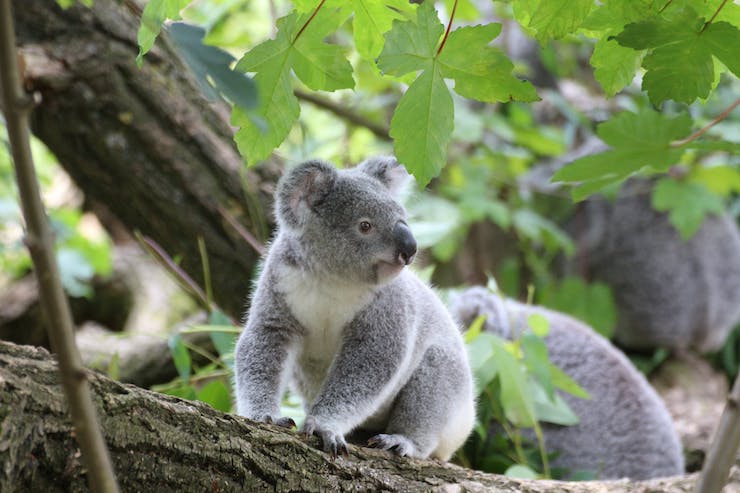
This year, Australia was hit by the worst wildfire season it has seen in decades. The world watched as the flames swept through the continent destroying everything in its path. Far too many human lives were lost along with thousands of homes and buildings, and millions of acres of land. Many of the images shared from the devastation showed how the fires effected Australia’s unique wildlife. Creatures like koalas and kangaroos, that have become national symbols of the country, were possibly some of the greatest victims of the wildfires. For slow moving creatures like koalas, Terri Irwin from The Australian Zoo explains that in a fire situation a koala’s instincts work against them. She said, “Koala instinct is to go up, as safety is in the top of the tree. Eucalyptus trees have so much oil that they ignite and actually explode in a fire.” Though koalas are not considered an endangered species, their numbers have greatly declined over the years. But since the wildfires, there is no way of knowing exactly how many koalas, and other creatures, have been lost.
Chris Dickman, an ecologist from the University of Sydney believes that the number of lost wildlife will be staggering. At first the estimates only included mammals, reptiles, and birds. Once the country’s bat and frog populations are taken into account he said, “Over a billion would be a very conservative figure.” The World Wide Fund for Nature (WWF) has gone on to estimate a possible 1.25 billion creatures could have been wiped out by the flames and the damage to their habitats. Now animal specialists are racing to save as many injured and misplaced animals before it is to late. But part of the problem is finding these animals, koalas in particular, as they are in hiding. To assist in this mission forest and wildlife officers have begun using drones to search for koalas.
For some time now drones have been being used to count wildlife populations. Dr. Grant Hamilton, from Queensland University of Technology’s School of Earth, Environmental and Biological Sciences ran a study on how drones can help count Australia’s koala population. He pointed out that using drones for this specific environment is very different than using drones to count animals that are out in the open, like seals on a beach or zebras on the Savannah. Koalas hide in dense forest, high in trees. Spotting them is very difficult. He said in the past human counters could spend an entire day out in the field trying to count koalas and only come back with a 70% accuracy. Using drones has greatly increased that number to nearly 86% accuracy with only a couple hours worth of time in the field.
The way that Hamilton was able to find the koalas was not because of a standard camera on the drone used to count other animals. Instead, he and his team equipped a drone with a camera that picks up the thermal heat signature of the koalas hidden from view in the trees. A drone flies over a predetermined area in a grid formation. As the camera records, a live feed of the forest is fed back to the team and they can see the shapes of the koala’s hiding in the trees as their heat signature is illuminated. “Nobody else has really managed to get good results anywhere in the world in a habitat this complex and in these kinds of numbers,” Dr Hamilton said. He also went on to point out that using a drone does not replace the functions of humans in the field, but as he said, “What we do know now is that this is a really powerful tool within the tool box.”
Dr. Hamilton went on the say that they hope to further use the drones to track other elusive mammals, birds, and insects. The drones could also be used to track invasive species like deer that have been destroying koala habitats. The success of this program has led rescuers to once again use the drones with thermal cameras to search for animals still hiding in the forests. Even though much of the land and trees have been destroyed, finding the koalas has been very difficult and unsafe sometimes. With the drone, officers can easily spot a koala in the treetops. Once the drone has found a koala it goes in for a closer look. The officer assesses the koala on a monitor to determine if it is in need of medical attention, relocation, or is safe on it’s own. If the koala needs attention the officers are using cherry pickers to reach them and bring them to a treatment center.
For now the firefighters seem to have the wildfires under control, but with Australia’s wildfire season lasting into April, who knows what will happen. Right now there is a rush to save as many injured animals in the wild. Sonja Elwood, founder of volunteer-run Sydney Wildlife rescue group, has been working around the clock with other volunteers to help. She said, “Everyone recognizes the real emergency is just this window of time we have to get out there and find what animals are injured and get them some help. There’s only so long animals can survive out there with these types of injuries. We figure in these burnt zones, we only have a three-week opportunity to find them.” This is why using drones to help locate injured animals has become so important. There is nothing that can be done for that animals that have already been lost. Hopefully, with the speed of location provided by drones the officers, vets, and volunteers can try to save as much of the remaining populations.
|